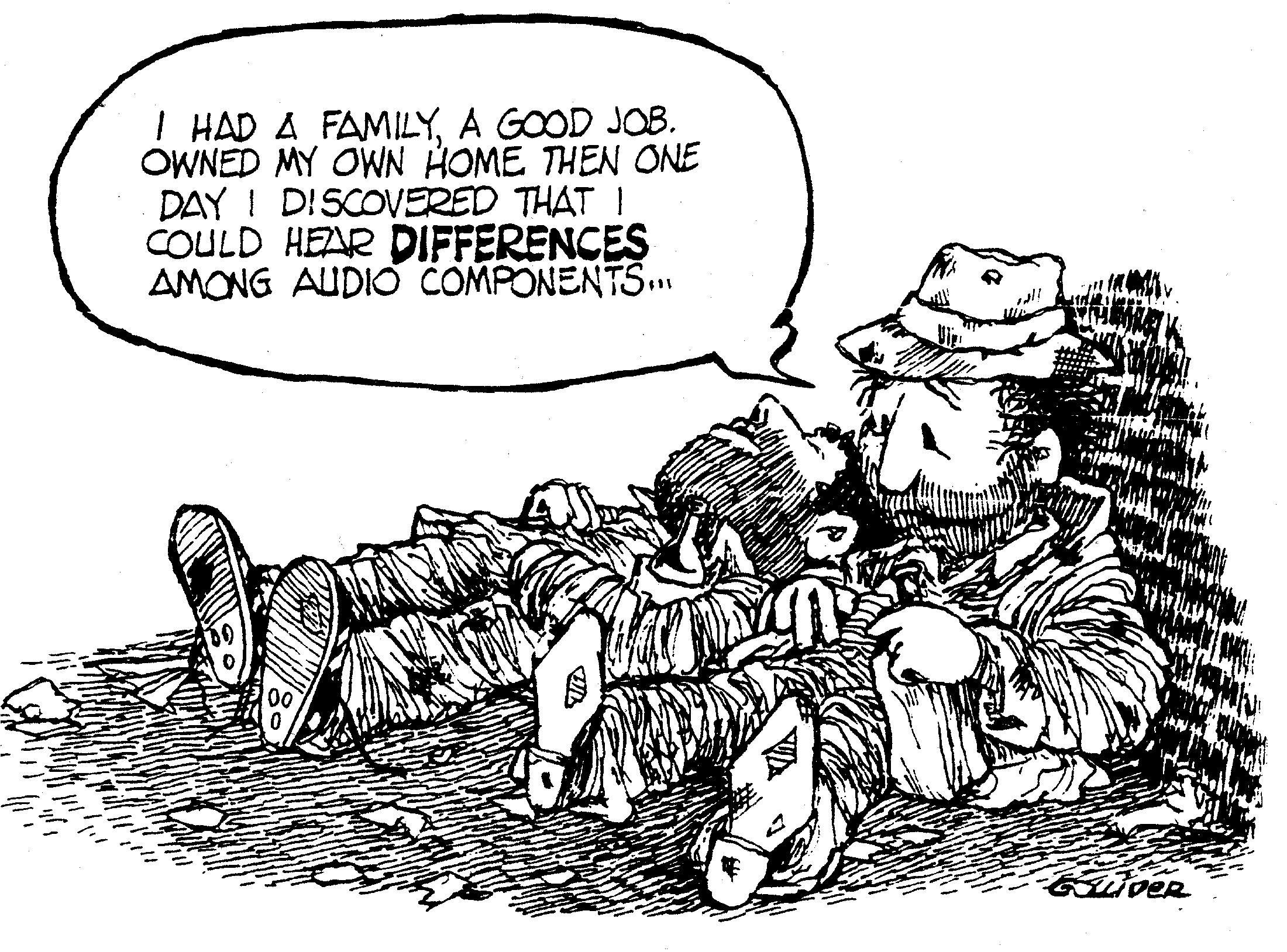Audiophilia nervosa. It’s a running gag with a mean streak. As audiophiles, we know its effects intimately. We know how it can turn what was once a source of pleasure and pride—listening to good music over a good sound system—into an irritating itch that can’t be scratched.The UrbanDictionary.com defines audiophilia nervosa (AN) as «the anxiety resulting from the never-ending quest to obtain the ultimate performance from one’s stereo system by means of employing state-of-the-art components, cables, and the use of certain ‘tweaks.’ Although the goal is supposedly to achieve maximum appreciation of the music, those afflicted with this condition are merely obsessed with their electronics.»
I wouldn’t go so far as to say merely obsessed with their electronics—AN is, at its root, a striving for musical bliss—but point taken: We can get carried away.
Ours, of course, is not the only hobby that can lead to obsessive behavior, but it may be more likely than most to elicit it. The underlying reason is this: Unless you’re a «retired» audiophile, being an «active» one is all about the journey: the ongoing quest to hear one’s music collection reproduced in ever more gratifying ways.
It’s a wonderful idea, steeped in notions of creative exploration, but it also suggests that the audiophile psyche is guided by two naturally related principles: 1) our search for better or more satisfying sound is based on a recurrent drive and 2) as perpetual dreamers chasing a concept as uncapturable and indefinite as «better sound,» our longings can never be indefinitely appeased by the unchanging musical renderings of any given audio system. It is inherent in the nature of our hobby that our love is unrequited.
And invariably, as we sit listening to our audiophile rigs, we become a couch reviewer armed with our own set of sound-related biases, reflexively judging the merits of what we hear: Is the sound too thin, too dark, not transparent enough? Is it faithful to the recording, to the performance? How can we even be sure? And how do we go about trying to change one aspect of the sound without compromising another?
It all goes with the territory, of course, but left unchecked, this kind of critical analysis can put us in a state of constant distraction that corrodes enjoyment. One reason for this is that so many variables contribute to what we hear from our sweet spots, including those having nothing to do with the machinery—such as our mood and/or hearing (footnote 1). The risk is that, by always trying to «fix» our audio systems, we end up using them more as tuning forks than as pipelines to creative nourishment.
Perhaps, then, the audiophile life should be savored as a series of stops along the way—the best of these stops move us forward, while the lesser ones we use to correct our course.
Which brings me to the most potentially treacherous of AN triggers: unrealistic expectations. The unvarnished, un-idealized reality is this: We can no more duplicate in our living rooms the sound of a symphony orchestra in a concert hall than we can reclaim that spark of enlightenment that made us fall in love with a piece of music in the first place. All we can hope for, on our musical pilgrimage, is that any change we make to our system or listening environment will bring us closer to our music. And that—despite whatever else the audio pundits think we should aim for—is probably the best explanation for why we do what we do: to get closer to how that music originally made us feel.
After all, what better reason to aspire to better sound than to increase our chances of experiencing and re-experiencing those magical moments of heightened musical intimacy, when new meanings or creative nuances in a beloved recording are revealed—or, better yet, to open the mind to a gem we have just discovered or at first overlooked? This, for me, is our hobby’s loftiest prize.
But, as with everything in life, being an audiophile can have its share of bad breaks—such as those times when AN won’t leave you alone. If that describes you, this is what I propose: Sever yourself entirely from the source of frustration and leave the hi-fi alone. Don’t touch it. Don’t glare at it. Forget it. Forget everything related to it, even Stereophile. Essentially, pretend you were never an audiophile.
Then, listen to music reproduced strictly by mainstream electronics of convenience that fly under the radar of the audiophile psyche: the car stereo and MP3 player, the boom box and kitchen radio. The trick here is to get by on decent sound—but not too decent. This is about the music. It’s about letting the music come to you instead of you running after it. It’s about letting it do its thing—the thing that used to make your heart go all aflutter, before things got so serious.
Do this for a week, a month—however long it takes to free yourself of audiophile pretensions and reinforce your bond with music’s intrinsic beauty, and to do so not only intellectually and emotionally, but on a visceral level. When the music moves you again in all of these ways—when it can mesmerize you and make you happy and bring you to your feet—that’s when you’ll know you’re ready to return to the audiophile fold. And when you do, and you’ve turned your hi-fi back on, I bet it will sound like a much better system than you thought it was when you turned it off.
I was a music lover way before I knew what a preamp was. It’s why, whenever audiophilia nervosa starts gnawing at my brain, I like to remind myself that what hooked me on music wasn’t the playback chain, or its soundstaging or imaging, or any other such geekspeak barometer—it was the music itself, and the way it made me feel.
Footnote 1: According to an article published in the Danish newspaper Politiken, our outer ears or pinnae, to compensate for progressive hearing loss due to aging, continue to grow—by about 2.2mm per year—to increase their ability to pick up and reflect soundwaves into the ear canals.




